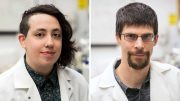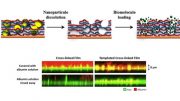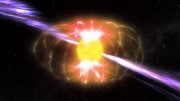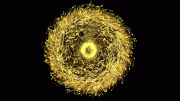
A team of physicists has discovered a new superconducting material with unique tunability for external stimuli, promising advancements in energy-efficient computing and quantum technology. This breakthrough, achieved through advanced research techniques, enables unprecedented control over superconducting properties, potentially revolutionizing large-scale industrial applications.
Material has potential applications in superconducting circuits for the next generation of industrial electronics.
Researchers used the Advanced Photon Source to verify the rare characteristics of this material, potentially paving the way for more efficient large-scale computing.
As industrial computing needs grow, the size and energy consumption of the hardware needed to keep up with those needs grows as well. A possible solution to this dilemma could be found in superconducting materials, which can reduce that energy consumption exponentially. Imagine cooling a giant data center full of constantly running servers down to nearly absolute zero, enabling large-scale computation with incredible energy efficiency.
Breakthrough in Superconductivity Research
Physicists at the University of Washington and the U.S. Department of Energy’s (DOE) Argonne National Laboratory have made a discovery that could help enable this more efficient future. Researchers have found a superconducting material that is uniquely sensitive to outside stimuli, enabling the superconducting properties to be enhanced or suppressed at will. This enables new opportunities for energy-efficient switchable superconducting circuits. The paper was published in Science Advances.
Superconductivity is a quantum mechanical phase of matter in which an electrical current can flow through a material with zero resistance. This leads to perfect electronic transport efficiency. Superconductors are used in the most powerful electromagnets for advanced technologies such as magnetic resonance imaging, particle accelerators, fusion reactors, and even levitating trains. Superconductors have also found uses in quantum computing.
Challenges and Innovations in Superconducting Technologies
Today’s electronics use semiconducting transistors to quickly switch electric currents on and off, creating the binary ones and zeroes used in information processing. As these currents must flow through materials with finite electrical resistance, some of the energy is wasted as heat. This is why your computer heats up over time. The low temperatures needed for superconductivity, usually more than 200 degrees Fahrenheit below freezing, makes those materials impractical for hand-held devices. However, they could conceivably be useful on an industrial scale.
The research team, led by Shua Sanchez of the University of Washington, examined an unusual superconducting material with exceptional tunability. This crystal is made of flat sheets of ferromagnetic europium atoms sandwiched between superconducting layers of iron, cobalt, and arsenic atoms. Finding ferromagnetism and superconductivity together in nature is extremely rare, according to Sanchez, as one phase usually overpowers the other.
“It is actually a very uncomfortable situation for the superconducting layers, as they are pierced by the magnetic fields from the surrounding europium atoms,” Sanchez said. “This weakens the superconductivity and results in a finite electrical resistance.”
Advanced Research Techniques and Findings
To understand the interaction of these phases, Sanchez spent a year as a resident at one of the nation’s leading X-ray light sources, the Advanced Photon Source (APS), a DOE Office of Science user facility at Argonne. While there he was supported by DOE’s Science Graduate Student Research program. Working with physicists at APS beamlines 4-ID and 6-ID, Sanchez developed a comprehensive characterization platform capable of probing the microscopic details of complex materials.
Using a combination of X-ray techniques, Sanchez and his collaborators were able to show that applying a magnetic field to the crystal can reorient the europium magnetic field lines to run parallel to the superconducting layers. This removes their antagonistic effects and causes a zero-resistance state to emerge. Using electrical measurements and X-ray scattering techniques, scientists were able to confirm that they could control the behavior of the material.
“The nature of independent parameters controlling superconductivity is quite fascinating, as one could map out a complete method of controlling this effect,” said Argonne’s Philip Ryan, a co-author on the paper. “This potential posits several fascinating ideas including the ability to regulate field sensitivity for quantum devices.”
The team then applied stresses to the crystal with interesting results. They found the superconductivity could be either boosted enough to overcome the magnetism even without re-orienting the field or weakened enough that the magnetic reorientation could no longer produce the zero-resistance state. This additional parameter allows for the material’s sensitivity to magnetism to be controlled and customized.
“This material is exciting because you have a close competition between multiple phases, and by applying a small stress or magnetic field, you can boost one phase over the other to turn the superconductivity on and off,” Sanchez said. “The vast majority of superconductors aren’t nearly as easily switchable.”
Reference: “Strain-switchable field-induced superconductivity” by Joshua J. Sanchez, Gilberto Fabbris, Yongseong Choi, Jonathan M. DeStefano, Elliott Rosenberg, Yue Shi, Paul Malinowski, Yina Huang, Igor I. Mazin, Jong-Woo Kim, Jiun-Haw Chu and Philip J. Ryan, 24 November 2023, Science Advances.
DOI: 10.1126/sciadv.adj5200









Superconductivity is a quantum mechanical phase of matter in which an electrical current can flow through a material with zero resistance.
Does the author want to know the physical essence of quantum and electric current? Does the author want to know where quantum gravity comes from?
The synchronous effect of topological vortex gravitational field interaction will guide you in the right direction.
I hope the author has not been fooled by the Physical Review Letters (PRL). Physical Review Letters (PRL) firmly believes that two objects (such as two sets of cobalt-60) of high-dimensional spacetime rotating in opposite directions can be transformed into two objects that mirror each other, and are unwilling to correct their mistakes. The Physics Review Letters (PRL) have created the most hypocritical, dirtiest, and ugliest era in the history of physics.
I hope more scientific workers dare to fight against rampant pseudoscience, rather than blindly following it.
Your rant doesn’t belong here.
I greatly appreciate your honesty. Physics Review Letters (PRL) prefer students like you.
You can go home and do a physics experiment as guided by the Physics Review Letters (PRL). Ask your father and mother to rotate in two opposite directions. In this way, they will become two people who mirror each other. At this time, how you should address your father and mother is up to you.
Science must be rigorous. The reckless behavior of Physics Review Letters (PRL) has seriously poisoned the academic atmosphere and people’s understanding of science, including Science and Nature.
If you are really interested in science, you can browse https://zhuanlan.zhihu.com/p/595280873.
Couldn’t see any mention of how much time or energy the switching took – even in the source article.
The most fascinating part was they have stated a calculable adjustment for different values, a complete method of controlling the effect, expand on the control.
This may be WAY out of my expertise, but, as I understand it, the power in a computer mainly comes the switching of the transisors, vs. the conduction of current through the silicon. The time it takes for the transistors to switch causes power dissipation because of the amount of time spent in the switching phase vs. the time between switching. That is why power dissipation of a microprocessor increases with clock speed. I don’t see how superconduction can help; it may even seriously hurt — will the transistors still operate at very low temperatures and how are the rise/fall times be affected?
Another week, another superconductor breaks ground.
With the rate of discoveries reported in magazines like this one, it’s a miracle that we’re not the masters of the universe yet.
Neat concept- switching SCs (super conductors). However, I would suspect the enegry consumption would still be significantly worse compared anything we currently have (for the same total operations / timeframe ). This due to there (AFAIK) being no RTSCs (Room Temperature Super Conductors), so although technically more efficient (for a closed system with 0K ambient temp) you essentially just applying effort to keep the system stable (in a near zero superconductivity state)… neat, but pointless in production until we are able to create functional RTSCs.
Also the article is kisleading it should probably read something like ‘practically all of the energy is wasted as heat’ instead of ‘some of the energy is wasted as heat’.
I suppose the effect has a significantly wide effective bandwidth for being driven, not sure what drives it though. An article a few years back seemed to imply it could be driven mechanically, e.g. as using a piezo and static pressure cell type of setup, I guess. Maybe it can be also triggered by weak electric fields in a similar setup.